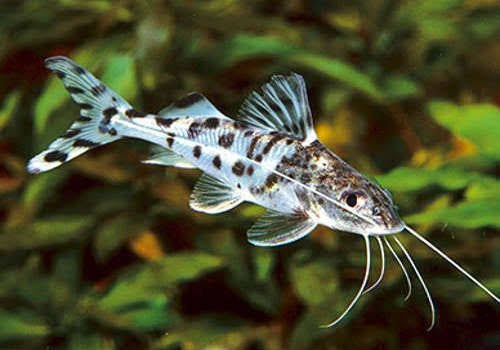
Catfish - Pictus 6cm Show
Guarantee Safe Checkout
Pictus Catfish
The Pictus Catfish (*Pimelodus pictus*) is a popular freshwater species known for its active behavior and distinct whisker-like barbels. Below is a care guide to help maintain a healthy environment for this fish:
### 1. **Tank Setup**
- **Tank Size:** Minimum 55 gallons, as Pictus catfish are active swimmers and need plenty of space.
- **Substrate:** Fine gravel or sand to prevent injury to their barbels.
- **Decorations:** Provide plenty of hiding places, such as driftwood, rocks, and plants, as they like to retreat to cover.
- **Lighting:** Moderate; not too bright, as they prefer dimly lit environments.
### 2. **Water Parameters**
- **Temperature:** 75-81°F (24-27°C)
- **pH:** 6.5-7.5
- **Water Hardness:** 5-15 dGH
- **Filtration:** Strong filtration is necessary due to their high activity level, which increases waste production. Ensure good water flow, as they prefer well-oxygenated water.
- **Water Changes:** Perform 25-30% water changes weekly to maintain water quality.
### 3. **Diet**
- **Omnivorous:** Feed a balanced diet consisting of:
- High-quality sinking pellets or wafers
- Frozen or live foods like bloodworms, brine shrimp, and daphnia
- Occasional vegetables, such as blanched zucchini or cucumber
- **Feeding Frequency:** Twice a day, providing enough food for them to consume in a few minutes.
### 4. **Behavior and Compatibility**
- **Activity:** Nocturnal and very active, especially at night. They will explore and scavenge the bottom of the tank.
- **Tank Mates:** Peaceful fish, but avoid housing with very small fish (like neon tetras), as Pictus may accidentally eat them. Good tank mates include:
- Larger tetras
- Barbs
- Gouramis
- Other peaceful catfish species
- **Schooling:** They prefer to be kept in groups of at least 3 to 5 for social interaction, but they can be kept alone if needed.
### 5. **Common Health Issues**
- **Barbel Damage:** Pictus catfish have long barbels, which can be easily damaged by rough substrate or poor water conditions. Keep water quality high and provide smooth surfaces.
- **Ich (White Spot Disease):** Like many tropical fish, they are susceptible to ich, which can be treated by raising the water temperature and using appropriate medication.
### 6. **Breeding**
- **Difficulty:** Breeding in home aquariums is extremely rare and difficult, as they require specific water conditions and environments that are hard to replicate. Most Pictus catfish in the aquarium trade are wild-caught.
### 7. **Lifespan**
- With proper care, Pictus catfish can live up to 8-10 years.
Providing the right environment and diet is key to maintaining a healthy Pictus catfish. Their active and inquisitive nature makes them a joy to watch, especially during feeding times.
Limited Quantity Available - Will Sell out Fast!
Note:
We can’t ship Livestock and Live Plants to WA and TAS due to State Restrictions. Kindly check out our DOA and other policies before purchase!!
What to Expect from Us
All Aquatic plants and animals come with a 100% live arrival guarantee!!

| Quantity |
1 catfish 6cm |
|---|
